Nicholas Roberts
Shammie
R&B: Domain Regrouping and Data Mixture Balancing for Efficient Foundation Model Training
May 01, 2025
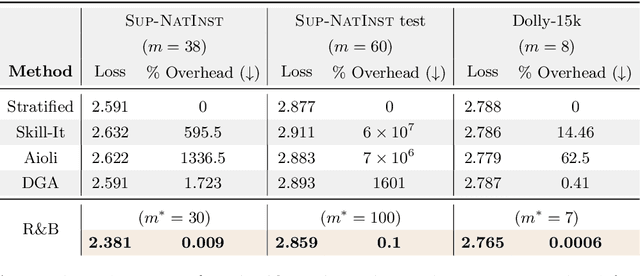
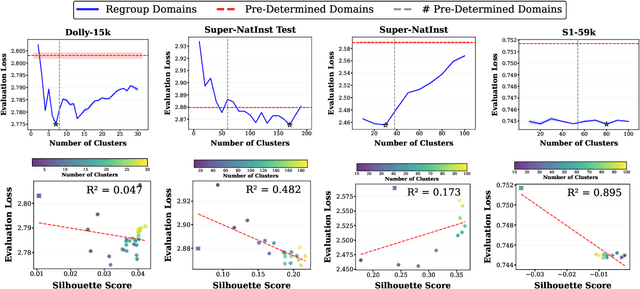
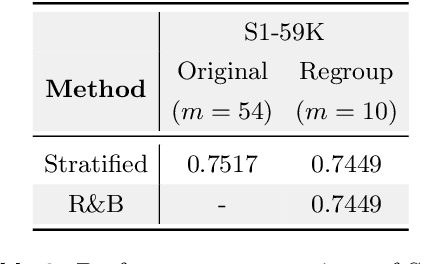
Abstract:Data mixing strategies have successfully reduced the costs involved in training language models. While promising, such methods suffer from two flaws. First, they rely on predetermined data domains (e.g., data sources, task types), which may fail to capture critical semantic nuances, leaving performance on the table. Second, these methods scale with the number of domains in a computationally prohibitive way. We address these challenges via R&B, a framework that re-partitions training data based on semantic similarity (Regroup) to create finer-grained domains, and efficiently optimizes the data composition (Balance) by leveraging a Gram matrix induced by domain gradients obtained throughout training. Unlike prior works, it removes the need for additional compute to obtain evaluation information such as losses or gradients. We analyze this technique under standard regularity conditions and provide theoretical insights that justify R&B's effectiveness compared to non-adaptive mixing approaches. Empirically, we demonstrate the effectiveness of R&B on five diverse datasets ranging from natural language to reasoning and multimodal tasks. With as little as 0.01% additional compute overhead, R&B matches or exceeds the performance of state-of-the-art data mixing strategies.
Compute Optimal Scaling of Skills: Knowledge vs Reasoning
Mar 13, 2025Abstract:Scaling laws are a critical component of the LLM development pipeline, most famously as a way to forecast training decisions such as 'compute-optimally' trading-off parameter count and dataset size, alongside a more recent growing list of other crucial decisions. In this work, we ask whether compute-optimal scaling behaviour can be skill-dependent. In particular, we examine knowledge and reasoning-based skills such as knowledge-based QA and code generation, and we answer this question in the affirmative: $\textbf{scaling laws are skill-dependent}$. Next, to understand whether skill-dependent scaling is an artefact of the pretraining datamix, we conduct an extensive ablation of different datamixes and find that, also when correcting for datamix differences, $\textbf{knowledge and code exhibit fundamental differences in scaling behaviour}$. We conclude with an analysis of how our findings relate to standard compute-optimal scaling using a validation set, and find that $\textbf{a misspecified validation set can impact compute-optimal parameter count by nearly 50%,}$ depending on its skill composition.
Tabby: Tabular Data Synthesis with Language Models
Mar 04, 2025Abstract:While advances in large language models (LLMs) have greatly improved the quality of synthetic text data in recent years, synthesizing tabular data has received relatively less attention. We address this disparity with Tabby, a simple but powerful post-training modification to the standard Transformer language model architecture, enabling its use for tabular dataset synthesis. Tabby enables the representation of differences across columns using Gated Mixture-of-Experts, with column-specific sets of parameters. Empirically, Tabby results in data quality near or equal to that of real data. By pairing our novel LLM table training technique, Plain, with Tabby, we observe up to a 44% improvement in quality over previous methods. We also show that Tabby extends beyond tables to more general structured data, reaching parity with real data on a nested JSON dataset as well.
MLGym: A New Framework and Benchmark for Advancing AI Research Agents
Feb 20, 2025



Abstract:We introduce Meta MLGym and MLGym-Bench, a new framework and benchmark for evaluating and developing LLM agents on AI research tasks. This is the first Gym environment for machine learning (ML) tasks, enabling research on reinforcement learning (RL) algorithms for training such agents. MLGym-bench consists of 13 diverse and open-ended AI research tasks from diverse domains such as computer vision, natural language processing, reinforcement learning, and game theory. Solving these tasks requires real-world AI research skills such as generating new ideas and hypotheses, creating and processing data, implementing ML methods, training models, running experiments, analyzing the results, and iterating through this process to improve on a given task. We evaluate a number of frontier large language models (LLMs) on our benchmarks such as Claude-3.5-Sonnet, Llama-3.1 405B, GPT-4o, o1-preview, and Gemini-1.5 Pro. Our MLGym framework makes it easy to add new tasks, integrate and evaluate models or agents, generate synthetic data at scale, as well as develop new learning algorithms for training agents on AI research tasks. We find that current frontier models can improve on the given baselines, usually by finding better hyperparameters, but do not generate novel hypotheses, algorithms, architectures, or substantial improvements. We open-source our framework and benchmark to facilitate future research in advancing the AI research capabilities of LLM agents.
ScriptoriumWS: A Code Generation Assistant for Weak Supervision
Feb 17, 2025Abstract:Weak supervision is a popular framework for overcoming the labeled data bottleneck: the need to obtain labels for training data. In weak supervision, multiple noisy-but-cheap sources are used to provide guesses of the label and are aggregated to produce high-quality pseudolabels. These sources are often expressed as small programs written by domain experts -- and so are expensive to obtain. Instead, we argue for using code-generation models to act as coding assistants for crafting weak supervision sources. We study prompting strategies to maximize the quality of the generated sources, settling on a multi-tier strategy that incorporates multiple types of information. We explore how to best combine hand-written and generated sources. Using these insights, we introduce ScriptoriumWS, a weak supervision system that, when compared to hand-crafted sources, maintains accuracy and greatly improves coverage.
Stronger Than You Think: Benchmarking Weak Supervision on Realistic Tasks
Jan 13, 2025Abstract:Weak supervision (WS) is a popular approach for label-efficient learning, leveraging diverse sources of noisy but inexpensive weak labels to automatically annotate training data. Despite its wide usage, WS and its practical value are challenging to benchmark due to the many knobs in its setup, including: data sources, labeling functions (LFs), aggregation techniques (called label models), and end model pipelines. Existing evaluation suites tend to be limited, focusing on particular components or specialized use cases. Moreover, they often involve simplistic benchmark tasks or de-facto LF sets that are suboptimally written, producing insights that may not generalize to real-world settings. We address these limitations by introducing a new benchmark, BOXWRENCH, designed to more accurately reflect real-world usages of WS. This benchmark features tasks with (1) higher class cardinality and imbalance, (2) notable domain expertise requirements, and (3) multilingual variations across parallel corpora. For all tasks, LFs are written using a careful procedure aimed at mimicking real-world settings. In contrast to existing WS benchmarks, we show that supervised learning requires substantial amounts (1000+) of labeled examples to match WS in many settings.
MoRe Fine-Tuning with 10x Fewer Parameters
Aug 30, 2024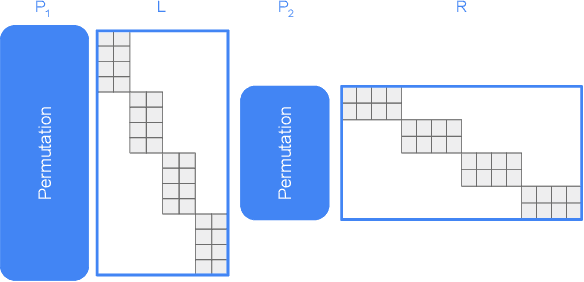

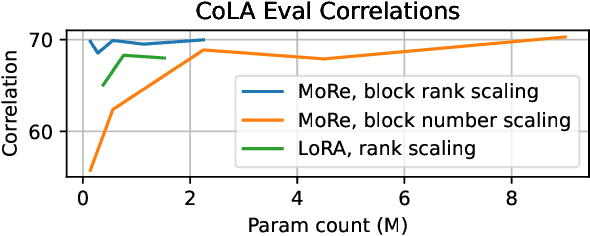

Abstract:Parameter-efficient fine-tuning (PEFT) techniques have unlocked the potential to cheaply and easily specialize large pretrained models. However, the most prominent approaches, like low-rank adapters (LoRA), depend on heuristics or rules-of-thumb for their architectural choices -- potentially limiting their performance for new models and architectures. This limitation suggests that techniques from neural architecture search could be used to obtain optimal adapter architectures, but these are often expensive and difficult to implement. We address this challenge with Monarch Rectangular Fine-tuning (MoRe), a simple framework to search over adapter architectures that relies on the Monarch matrix class. Theoretically, we show that MoRe is more expressive than LoRA. Empirically, our approach is more parameter-efficient and performant than state-of-the-art PEFTs on a range of tasks and models, with as few as 5\% of LoRA's parameters.
Pretrained Hybrids with MAD Skills
Jun 02, 2024



Abstract:While Transformers underpin modern large language models (LMs), there is a growing list of alternative architectures with new capabilities, promises, and tradeoffs. This makes choosing the right LM architecture challenging. Recently-proposed $\textit{hybrid architectures}$ seek a best-of-all-worlds approach that reaps the benefits of all architectures. Hybrid design is difficult for two reasons: it requires manual expert-driven search, and new hybrids must be trained from scratch. We propose $\textbf{Manticore}$, a framework that addresses these challenges. Manticore $\textit{automates the design of hybrid architectures}$ while reusing pretrained models to create $\textit{pretrained}$ hybrids. Our approach augments ideas from differentiable Neural Architecture Search (NAS) by incorporating simple projectors that translate features between pretrained blocks from different architectures. We then fine-tune hybrids that combine pretrained models from different architecture families -- such as the GPT series and Mamba -- end-to-end. With Manticore, we enable LM selection without training multiple models, the construction of pretrained hybrids from existing pretrained models, and the ability to $\textit{program}$ pretrained hybrids to have certain capabilities. Manticore hybrids outperform existing manually-designed hybrids, achieve strong performance on Long Range Arena (LRA) tasks, and can improve on pretrained transformers and state space models.
Skill-it! A Data-Driven Skills Framework for Understanding and Training Language Models
Jul 26, 2023Abstract:The quality of training data impacts the performance of pre-trained large language models (LMs). Given a fixed budget of tokens, we study how to best select data that leads to good downstream model performance across tasks. We develop a new framework based on a simple hypothesis: just as humans acquire interdependent skills in a deliberate order, language models also follow a natural order when learning a set of skills from their training data. If such an order exists, it can be utilized for improved understanding of LMs and for data-efficient training. Using this intuition, our framework formalizes the notion of a skill and of an ordered set of skills in terms of the associated data. First, using both synthetic and real data, we demonstrate that these ordered skill sets exist, and that their existence enables more advanced skills to be learned with less data when we train on their prerequisite skills. Second, using our proposed framework, we introduce an online data sampling algorithm, Skill-It, over mixtures of skills for both continual pre-training and fine-tuning regimes, where the objective is to efficiently learn multiple skills in the former and an individual skill in the latter. On the LEGO synthetic in the continual pre-training setting, Skill-It obtains 36.5 points higher accuracy than random sampling. On the Natural Instructions dataset in the fine-tuning setting, Skill-It reduces the validation loss on the target skill by 13.6% versus training on data associated with the target skill itself. We apply our skills framework on the recent RedPajama dataset to continually pre-train a 3B-parameter LM, achieving higher accuracy on the LM Evaluation Harness with 1B tokens than the baseline approach of sampling uniformly over data sources with 3B tokens.
Geometry-Aware Adaptation for Pretrained Models
Jul 23, 2023Abstract:Machine learning models -- including prominent zero-shot models -- are often trained on datasets whose labels are only a small proportion of a larger label space. Such spaces are commonly equipped with a metric that relates the labels via distances between them. We propose a simple approach to exploit this information to adapt the trained model to reliably predict new classes -- or, in the case of zero-shot prediction, to improve its performance -- without any additional training. Our technique is a drop-in replacement of the standard prediction rule, swapping argmax with the Fr\'echet mean. We provide a comprehensive theoretical analysis for this approach, studying (i) learning-theoretic results trading off label space diameter, sample complexity, and model dimension, (ii) characterizations of the full range of scenarios in which it is possible to predict any unobserved class, and (iii) an optimal active learning-like next class selection procedure to obtain optimal training classes for when it is not possible to predict the entire range of unobserved classes. Empirically, using easily-available external metrics, our proposed approach, Loki, gains up to 29.7% relative improvement over SimCLR on ImageNet and scales to hundreds of thousands of classes. When no such metric is available, Loki can use self-derived metrics from class embeddings and obtains a 10.5% improvement on pretrained zero-shot models such as CLIP.
 Add to Chrome
Add to Chrome Add to Firefox
Add to Firefox Add to Edge
Add to Edge